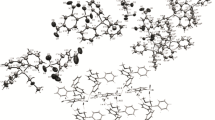Abstract
The reactions of equimolar amounts of tetraorganylphosphonium chloride with 2,5-dichlorobenzenesulfonic, 2,4-dinitrobenzenesulfonic, and 2-carboxybenzenesulfonic acids in water afford organyltriphenylphosphonium organosulfonates [Ph3PR][OSO2R'] (R = Ph, R' = C6H3Cl2-2,5 (I); R = C6H11-cyclo, R' = C6H3Cl2-2,5 (II); R = CH2OMe, R' = C6H3(NO2)2-2,4 (III); R = CH2OMe, R' = C6H4(COOH-2) (IV)). According to the X-ray diffraction (XRD) data (CIF files ССDС nos. 2142598 (I), 2144330 (II), 2144708 (III), and 2145604 (IV)), the complexes are ionic. The phosphorus atoms in the cations of complexes I‒IV are characterized by the tetrahedral coordination, and the organosulfonate anions have the usual geometry with the tetrahedral sulfur atom. The Р−С bond lengths are 1.7665(18)−1.836(2) Å, and the СРС bond angles vary in a range of 103.81(6)°−113.43(7)°. The structural organization in the crystals of complexes I−IV is formed by numerous weak hydrogen bonds between the cations and anions, such as S=O···H−CAr, N=O···H−CAr, C=O···H−CAr, etc. The arenesulfonate anions in complex I are structured into dimers by molecules of water of crystallization.





Similar content being viewed by others
REFERENCES
Purdela, D. and Vilceanu, R., Chimia Compusilor Organici al Fosforului si al Acizilor Lui, Bucharest: Academici, 1965.
Barton, D. and Ollis, W.D., Comprehensive Organic Chemistry. Vol. 2. Phosphorus Compounds. Vol. 3. Sulphur Compounds, Oxford: Pergamon, 1979.
Razuvaev, G.A., Osanova, N.A., Brilkina, T.G., et al., J. Organomet. Chem., 1975, vol. 99, no. 1, p. 93. https://doi.org/10.1016/S0022-328X(00)86365-2
Wang, D. and Astruc, D., Chem. Rev., 2015, vol. 115, p. 6621. https://doi.org/10.1021/acs.chemrev.5b00203
Cordovilla, C., Bartolome, C., Martinez-Ilarduya, J.M., et al., ACS Catal., 2015, vol. 5, p. 3040. https://doi.org/10.1021/acscatal.5b00448
Chong, C.C., Hirao, H., and Kinjo, R., Angew. Chem., Int. Ed. Engl., 2015, vol. 127, p. 192. https://doi.org/10.1002/ange.201408760
Shatutin, V.V., Senchurin, V.S., Sharutina, O.K., et al., Russ. J. Gen. Chem., 2009, vol. 79, no. 1, p. 78. https://doi.org/10.1134/S1070363209010125
Sharutin, V.V., Sharutina, O.K., Rybakova, A.V., et al., Russ. J. Gen. Chem., 2018, vol. 88, no. 8, p. 1629. https://doi.org/10.1134/S1070363218080133
Sharutin, V.V., Mukusheva, N., and Urzhumova, A.V., Bull. South Ural State Univ., Ser. Chem., 2018, vol. 10, no. 2, p. 48. https://doi.org/10.14529/chem180206
Sharutin, V.V., Sharutina, O.K., and Gubanova, Yu.O., Izv. Vyssh. Uchebn. Zaved. Khim. Khim. Tekhnol., 2019, vol. 62, no. 2, p. 4. https://doi.org/10.6060/ivkkt.20196202.5823
Akutsu, H., Masaki, K., Mori, K., et al., Polyhedron, 2005, vol. 24, p. 2126. https://doi.org/10.1016/j.poly.2005.03.023
Galpothdeniya, W.I.S., Fronczek, F.R., Cong, M., et al., J. Mater. Chem. B, 2016, vol. 4, no. 8, p. 1414. https://doi.org/10.1039/C5TB02038G
Akutsu, H., Yamada, J., Nakatsuji, S., et al., CrystEngComm, 2009, vol. 11, no. 12. P. 2588. https://doi.org/10.1039/b909519e
Onoda, A., Yamada, Y., Doi, M., et al., Inorg. Chem., 2001, vol. 40, no. 3, p. 516. https://doi.org/10.1021/ic0003067
Akutsu, H., Ishihara, K., Ito, S., et al., Polyhedron, 2017, vol. 136, p. 23. https://doi.org/10.1016/j.poly.2017.02.001
Camerel, F., Le Helloco, G., Guizouarn, T., et al., Cryst. Growth Des., 2013, vol. 13, no. 11, p. 5135. https://doi.org/10.1021/cg401416h
Ferrer, E.G., Williams, P.A.M., and Castellano, E.E., Z. Anorg. Allg. Chem., 2002, vol. 628, p. 1979. https://doi.org/10.1002/1521-3749(200209)628:9/10<1979::AID-ZAAC1979>3.0.CO;2-V
SMART and SAINT-Plus. Versions 5.0. Data Collection and Processing Software for the SMART System, Madison: Bruker AXS Inc., 1998.
SHELXTL/PC. Versions 5.10. An Integrated System for Solving, Refining and Displaying Crystal Structures from Diffraction Data, Madison: Bruker AXS Inc., 1998.
Dolomanov, O.V., Bourhis, L.J., Gildea, R.J., et al., J. Appl. Crystallogr., 2009, vol. 42, p. 339. https://doi.org/10.1107/S0021889808042726
Tarasevich, B.N., IR Spectra of the Main Classes of Organic Compounds. Reference Materials, Moscow: MSU, 2012.
Vasiliev, A.V., Grinenko, E.V., and Schukin, A.O., Infrared Spectroscopy of Organic and Natural Compounds: Textbook, St. Petersburg: SPbGLTA, 2007.
Ruther, R., Huber, F., and Preut, H., J. Organomet. Chem., 1985, vol. 295, no. 1, p. 21. https://doi.org/10.1016/0022-328X(85)88068-2
Sharutin, V.V., Egorova, I.V., Ivanenko, T.K., et al., Russ. J. Coord. Chem., 2003, vol. 29, p. 468. https://doi.org/10.1023/A:1024722812183
Cordero, B., Gómez, V., Platero-Prats, A.E., et al., Dalton Trans., 2008, no. 21, p. 2832. https://doi.org/10.1039/B801115J
Funding
This work was supported by regular institutional funding, and no additional grants were obtained.
Author information
Authors and Affiliations
Corresponding author
Ethics declarations
The authors declare that they have no conflicts of interest.
Additional information
Translated by E. Yablonskaya
Rights and permissions
About this article
Cite this article
Sharutin, V.V., Sharutina, O.K. & Mekhanoshina, E.S. Synthesis and Structures of Organyltriphenylphosphonium Organosulfonates [Ph3PR][OSO2R'] (R = Ph, R' = C6H3Cl2-2,5; R = C6H11-cyclo, R' = C6H3Cl2-2,5; R = CH2OMe, R' = C6H3(NO2)2-2,4; R = CH2OMe, R' = C6H4(COOH-2)). Russ J Coord Chem 49, 458–464 (2023). https://doi.org/10.1134/S1070328423600341
Received:
Revised:
Accepted:
Published:
Issue Date:
DOI: https://doi.org/10.1134/S1070328423600341




